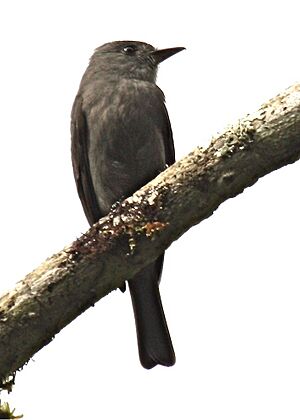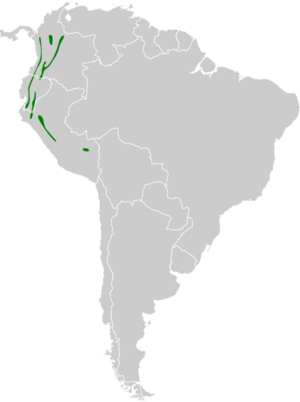Uniform antshrike facts for kids
Quick facts for kids Uniform antshrike |
|
|---|---|
 |
|
| Conservation status | |
| Scientific classification | |
| Genus: |
Thamnophilus
|
| Species: |
unicolor
|
 |
|
The uniform antshrike (Thamnophilus unicolor) is a special type of bird. It belongs to a group called "typical antbirds." You can find this bird in Colombia, Ecuador, and Peru.
Contents
Meet the Uniform Antshrike!
What is a Uniform Antshrike?
The uniform antshrike was first described by a scientist named Philip Sclater in 1859. He gave it a scientific name, Dysithamnus unicolor. Later, it was moved to a different group called Thamnophilus. This group was created by Louis Pierre Vieillot in 1816.
The uniform antshrike is closely related to other birds. These include the white-shouldered antshrike and the upland antshrike. They are like close cousins in the bird family.
There are three slightly different kinds, or subspecies, of the uniform antshrike:
- T. u. unicolor (the original one)
- T. u. grandior
- T. u. caudatus
What Does It Look Like?
The uniform antshrike is about 14.5 to 17 cm (5.7 to 6.7 in) long. It weighs around 24 grams (0.85 oz). That's about as much as a few quarters!
These birds have strong bills with a hook at the end. This hook is like the one found on a shrike bird.
Boys and girls of this bird look quite different. This is called sexual dimorphism.
- Adult male birds are mostly deep gray or blackish-gray. Sometimes they have white tips on their tail feathers.
- Adult female birds have a reddish-brown cap on their head. Their face is gray. Their upper body is reddish-brown, and their belly is pale reddish-brown.
- Young birds of both sexes look similar to the adult females.
All uniform antshrikes have gray-white eyes. They have a black bill and gray or blue-gray legs and feet.
Subspecies Differences
The T. u. grandior subspecies looks very much like the original kind. However, the males often have more white tips on their tail feathers.
Males of the T. u. caudatus subspecies look about the same as grandior males. But the females are darker and more reddish-brown than the other two types.
Where Does It Live?
The uniform antshrike lives in different areas that are not connected. This is called a disjunct distribution.
- The original subspecies, T. u. unicolor, lives on the Pacific side of the Andes mountains in Ecuador.
- T. u. grandior is found in all three mountain ranges of the Colombian Andes. It also lives on the east side of the Andes from southern Ecuador into northern Peru.
- T. u. caudatus lives on the eastern side of the Andes in Peru.
These birds like to live in the lower parts of wet montane forests. They prefer the edges of the forest and open spots where trees have fallen.
They live at different heights in the mountains:
- In Colombia, they are found between 1,200 and 2,200 meters (3,900 and 7,200 ft) high.
- In Ecuador, they mostly live between 1,000 and 2,000 meters (3,300 and 6,600 ft) high.
- In Peru, they are found between 1,250 and 2,300 meters (4,100 and 7,500 ft) high.
How Does It Behave?
Always Home: Movement
Scientists believe the uniform antshrike stays in the same area all year long. It does not migrate.
What's for Dinner? Feeding Habits
We don't know all the details about what uniform antshrikes eat. But they mostly eat insects and other arthropods. They also sometimes eat seeds.
They usually look for food alone or in pairs. They almost always stay in thick plants. They rarely join groups of different bird species looking for food together.
These birds usually forage very close to the ground. But sometimes they will feed as high as 8 meters (26 ft) up in a tree. They hop among branches, reaching out to grab prey from leaves, stems, and vines. They might also poke into bunches of dead leaves.
Building a Family: Reproduction
The uniform antshrike is thought to have one partner for life. This is called being monogamous. Their breeding season is not fully known. But in Colombia, it seems to be from February to June.
They build a deep, cup-shaped nest from plant fibers. The nest is often covered with moss that hangs down. We don't know how many eggs they lay. We also don't know how long the eggs take to hatch or when the young birds leave the nest. Details about how the parents care for their babies are also unknown.
Listen Up! Vocalization
The uniform antshrike's song is simple. It's a short series of nose-like notes, like "anh, anh, anh, anh." Sometimes there are three or five notes. It can also sound like a slightly faster series of 4 to 8 high, falling notes, "NYAH NYAH-nyah-nyah."
The song of the T. u. caudatus subspecies is similar but has a higher pitch.
They also make different calls:
- A rattling sound, like "kar'r'r'r'" or a "gruff bark-rattle...trr-grr'r'r."
- A falling whine.
- A deep, falling caw, like "raahhh."
What is Its Status?
The IUCN (International Union for Conservation of Nature) has looked at the uniform antshrike. They have decided it is a species of "Least Concern." This means it is not currently in danger of disappearing.
It lives in a large area. We don't know exactly how many of these birds there are. But their numbers are thought to be going down. No immediate dangers have been found for them.
The bird is considered fairly common in Colombia. It's less common in Ecuador, but there are more in the western part. In Peru, it's uncommon to fairly common.
Human activities don't have a big short-term effect on this bird. However, destroying their forest home can cause local problems for them.


